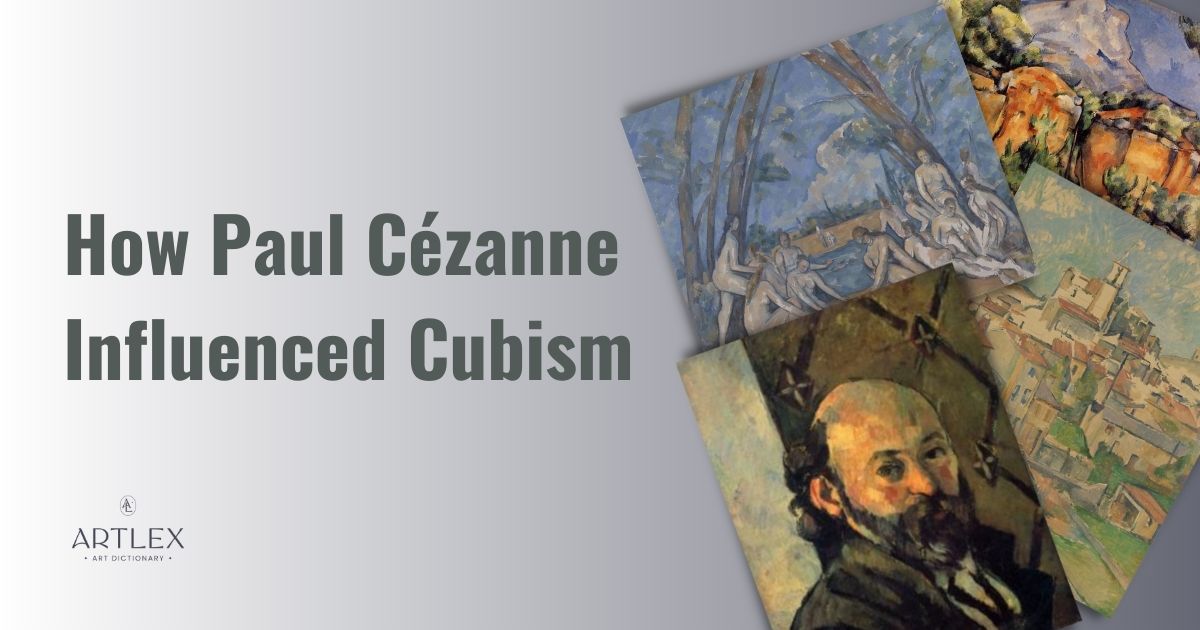
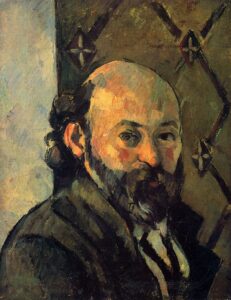
Paul Cézanne (1839-1906) was a French Post-Impressionist painter and one of the most influential figures in early Cubism. Cézanne is also widely regarded as a pioneer of Modern art. Cézanne’s use of perspective and geometric shapes predicted the multiple visible planes and geometric compositions central to the Cubist movement.
Cézanne painted in various styles, including landscapes, portraits, and still lifes. Cézanne’s paintings are recognizable for their vibrant colors, painterly brushstrokes, and novel approach to perspective. Cézanne rejected traditional approaches to linear perspective by painting people, landscapes, and objects within a composition as though they are seen from multiple angles at once. Cézanne also applied paint using loose brush strokes to construct geometric forms.
Cézanne was briefly involved with the Impressionist movement before pursuing his unique painting style. Cézanne maintained a few techniques central to the Impressionist movement, such as “broken brushwork” and “constructive brushstrokes,” evident in his paintings. However, Cézanne refined these painting techniques to render his subjects in vivid color contrast and on geometric planes. Cézanne was keenly interested in simplifying natural forms to their geometric foundations.
Cézanne’s distinctive style of constructing shape with color and his analytical approach to landscapes impacted Cubists, Fauves, and subsequent generations of avant-garde painters.
Cézanne’s paintings, such as Gardanne (1885-86), foreshadow Georges Braque’s and Pablo Picasso’s Cubism. Cézanne’s influence on early Cubism is seen particularly in Braque’s impressions of the French town of L’Estaque and Picasso’s self-portraits.
Cézanne’s vivid, volumetric, and geometric patterns are reproduced and refined in Georges Braque’s Houses at L’Estaque (1908). In this painting, the connection between Braque’s and Cézanne’s work is evident in the nod to L’Estaque, which Cézanne had painted many times before. Braque’s use of the same geometric style and patterns is also apparent.
Cézanne’s profound influence on Braque and Picasso, and all of Modern art itself, is also noted in a famous statement, where Picasso refers to Cézanne as “the father of us all.”
Cézanne’s Influences: Geometric Shapes
Cézanne interpreted nature through geometric shapes, which significantly influenced Cubism. Cézanne often reduced his subjects to their primary geometric forms. For instance, a tree was a strategic combination of cylinders, and an apple was a sphere. According to Cézanne’s artwork, cones, spheres, cylinders, and cubes are at the basis of every form in existence. This belief was essential to the origin of Cubism and its subsequent growth through the work of Picasso and Braque.
Cézanne also used color to emphasize geometric elements in his subject matter. Cézanne’s treatment of form allowed him to create volume through planes of modulated color, where a single shape would shift from dark to light, warm to cool. Cézanne used contrasting colors to assemble his compositions without any precise use of line.
Cézanne’s Influences: Perspective
Cézanne’s play on traditional one-point perspective influenced the fragmented aesthetic of Cubism. Cézanne experimented with the rules of perspective and painted his objects with flattened surfaces, simultaneously showing the subject from multiple angles. Each item appears to hint at its unique position and point of view.
Cézanne achieved an almost blurred appearance in his paintings by emphasizing the angles of each object individually rather than maintaining a single perspective of the entire scene. Cézanne’s technique resulted in a moderately distorted, abstracted appearance that later became central to Cubism.
Cubist artists such as Braque and Picasso expanded on Cézanne’s use of distortion by simultaneously presenting multiple views of the same subject from varied positions. This technique resulted in a picture plane that was even more abstract than anything Cézanne ever painted. Fragmented, flattened, and geometric subjects are recognized as the trademarks of the Cubist style.
Paul Cézanne Cubism Paintings
Cézanne worked at Gardanne, a hill village near his birthplace, Aix-en-Provence, from the summer of 1885 until the spring of 1886. He painted the aptly named oil painting Gardanne (1885-86), seen in the image below, which significantly influenced the Cubist style:
Gardanne (1885-86)
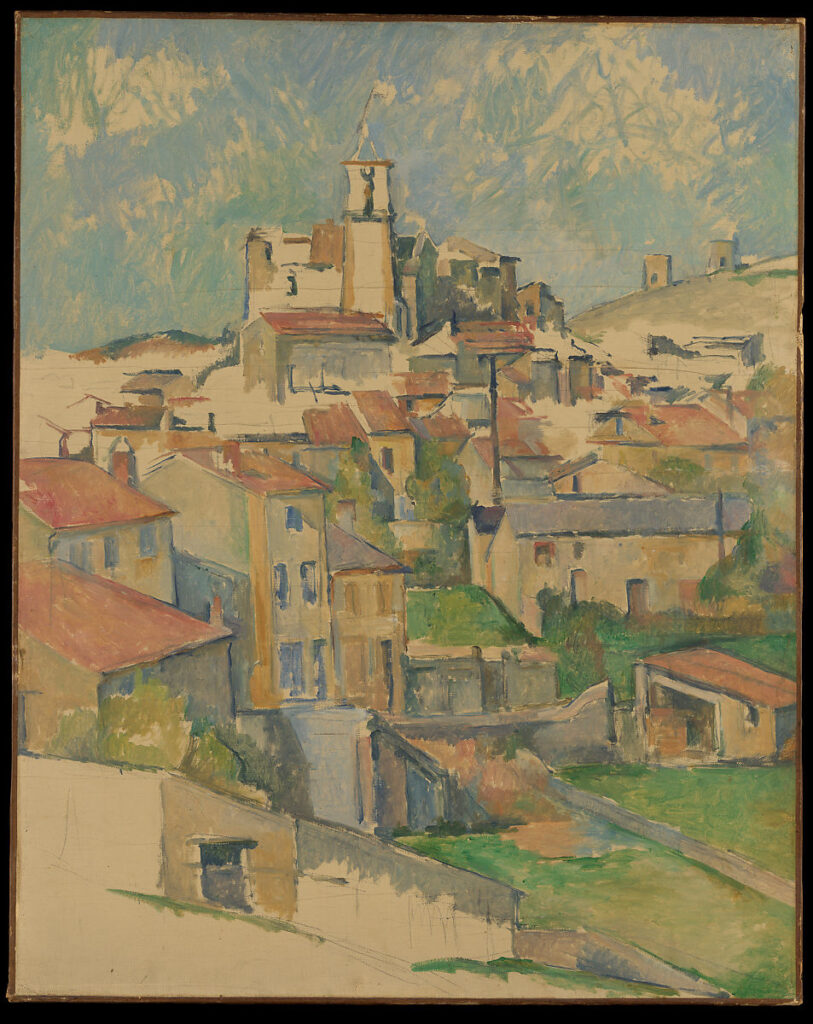
Two main influences on Cubism are evident in Cézanne’s Gardanne: geometric forms and a play on traditional perspective. Evidence of geometric forms is seen mainly in the structures, such as the local church’s steeple and the grouping of red-roofed dwellings.
The geometric structures are also faceted in that Cézanne has skewed the scene’s perspective to reflect the possibility that multiple angles could be seen simultaneously in a single picture plane.
Mont Sainte-Victoire Seen from the Bibemus Quarry (ca. 1897)
Cézanne’s painting Mont Sainte-Victoire Seen from the Bibemus Quarry (ca. 1897) is another of his later works whose style is reflected in early Cubist artwork. One of his numerous paintings of the region around his home, Mont Sainte-Victoire, depicts cube-like dwellings and heavy, almost spherical trees. See below:
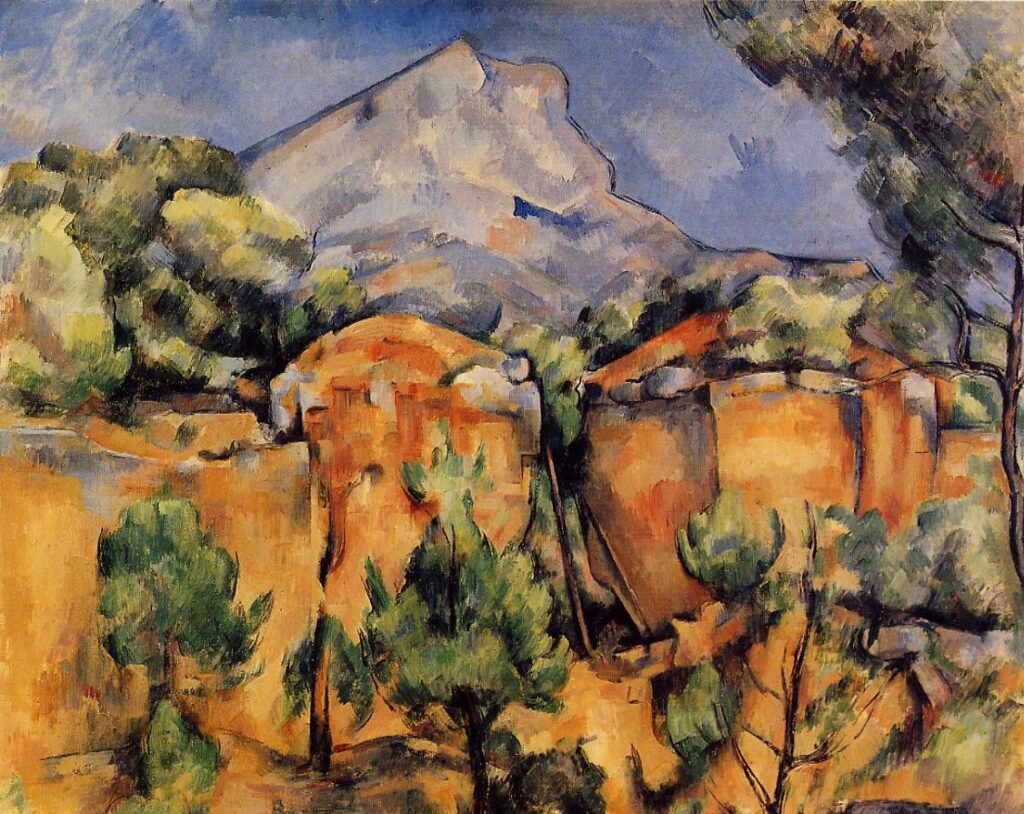
Cézanne uses receding planes of modulated color to impact perspective and the general roundness of forms. Once again, Cézanne’s treatment of perspective leaves the entire painting in a state of semi-abstraction, foreshadowing the near-total abstraction of Cubism.
The Large Bathers (1900-1906)
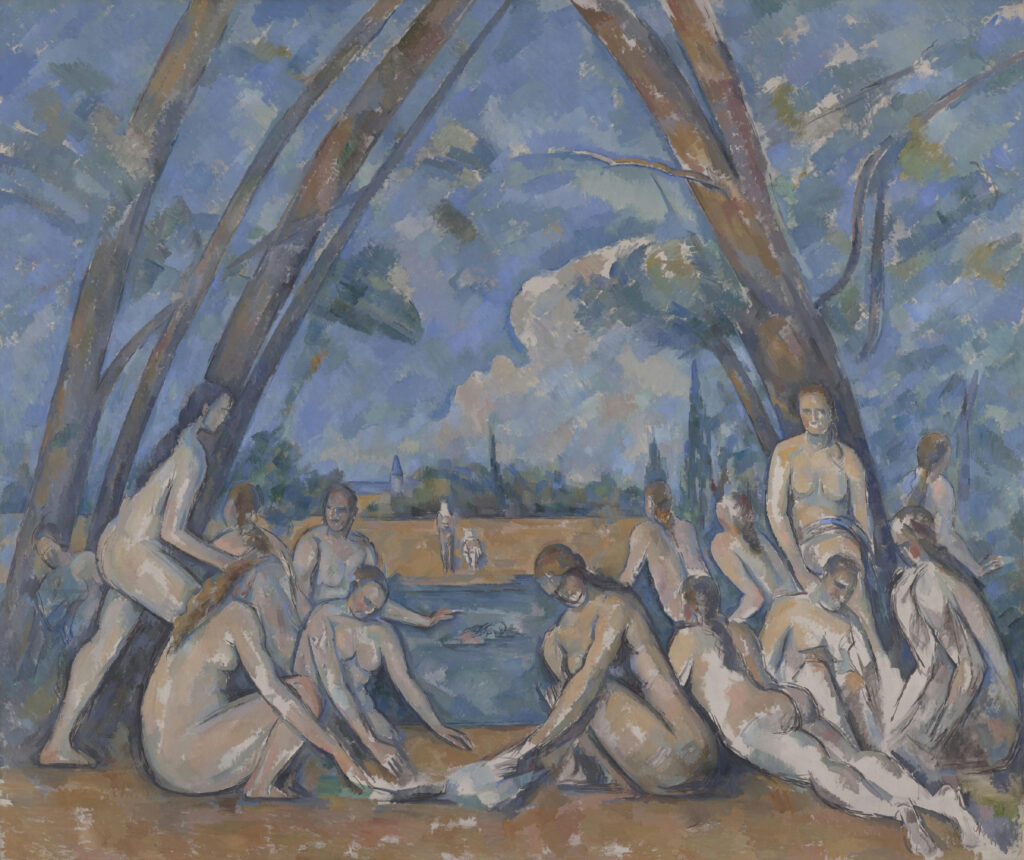
Another apparent influence on Cubism is Cézanne’s The Large Bathers (1900-1906), pictured above. In The Large Bathers, Cézanne painted a group of nude women relaxing near a lake. Cézanne’s monumental oil painting is rendered in his signature Post-Impressionist style, with geometric forms and modulated color to enhance the elements of roundness he perceived in nature.
Other Influences on Cubism
In addition to Cézanne, other art styles, such as Cycladic and African art, also influenced the development of Cubism. African tribal masks influenced cubist artists such as Pablo Picasso. African tribal masks present a vivid human image but are not naturalistic, in the sense that the expected parts of the face are all present but are abstracted in some way.
Cycladic art is a long-overlooked influence on Cubism and much of Modern art. Given its prehistoric Greek origins, much is yet to be discovered about Cycladic art. However, artifacts from as early as 3200 BCE reveal stylistic qualities very similar to those of Cubism, despite disparities in function.
Cubism borrowed aesthetic elements from both African art and Cycladic art, leaving behind the symbolic function of many artifacts. In Cycladic art, sculptures of people are also reduced to their essential forms, such as elongated faces hardly having more than the bridge of a nose and a neck for support. This suggests that Cycladic peoples were more concerned with the essence of an object or person rather than the minute details of its appearance.
